- within Intellectual Property topic(s)
- with Senior Company Executives, HR and Finance and Tax Executives
- in United States
- with readers working within the Chemicals, Technology and Media & Information industries
Patent eligibility under 35 U.S.C. § 101 should be a straightforward threshold question: any "new and useful process, machine, manufacture, or composition of matter" is eligible for protection. Yet over time, this once-clear principle has become anything but.
Although the statute itself has remained unchanged for two centuries, its interpretation has evolved dramatically through judicial decisions. And it is this common law precedent that has shaped the approach to the determination of patent subject matter eligibility.
Courts have carved out broad, judge-made exceptions to patentability, excluding laws of nature, natural phenomena, and abstract ideas. These exceptions, intended to be narrow, have become a source of uncertainty in modern patent law.
The Supreme Court's 2014 decision in Alice Corp. Pty. v. CLS Bank International, established a now-familiar two-step framework for assessing patent eligibility. Under step 1, courts ask whether the claims are directed to one of these judicially-defined ineligible concepts. If so, under step 2, courts look for an "inventive concept" that transforms the claim into a patent-eligible application.
In theory, the Alice test was meant to clarify. In practice, it has only deepened the uncertainty. Over the past 11 years since the Alice decision, courts have applied the two-step approach to determine patent eligibility, resulting in an ever-increasing number of invalidations under Section 101. Many believe this trend has expanded Section 101 far beyond its intent, deterring innovation in precisely the fields that need protection most—software, artificial intelligence, and biotechnology. Others maintain that courts are taking Section 101, and the common law application, to its logical conclusion in light of rapid technological advancements.
Given these contrasting viewpoints, litigants—and lower courts—have called on the Supreme Court to provide further clarity to Section 101 determinations. The Supreme Court has repeatedly declined this invitation, and hasn't heard a patent case since November 2022. For example, in March, the Supreme Court denied cert in Impact Engine v. Google, which involved an appeal of a Federal Circuit decision holding Impact's patent claims relating to web-based advertising systems invalid under Section 101.
For its part, Congress has been considering legislative reform to Section 101. Last spring, the Patent Eligibility Restoration Act (PERA) was reintroduced. PERA would eliminate the judicially created exceptions to patent eligibility (e.g., laws of nature, natural phenomena, and abstract ideas) codifying a more predictable framework. The proposed legislation would still exclude certain subject matter, such as mathematical formulas not tied to a practical application, purely mental processes, unmodified human genes and natural materials, and processes that are substantially economic, financial, business, social, cultural, or artistic.
Proponents of PERA stress the need for legislative clarity and urge that Section 101 jurisprudence "requires significant modification and clarification" and the bill itself notes "[m]any judges . . . have explicitly expressed the need for more guidance with respect to the meaning of section 101." PERA is currently being considered in both the House and Senate.
The recently-appointed Director of the Patent and Trademark Office, John Squires, has echoed these concerns. On October 9th, Squires publicly commented that courts have "misinterpreted" the Supreme Court's prior decisions regarding Section 101, including the Alice decision, which have been "wielded as bludgeons to exclude entire classes of inventions." According to Squires, "Section 101 should not be misused as a blunt instrument to exclude entire technological fields. To do so risks disqualifying exactly the kinds of advances America needs most – advances in artificial intelligence, biotechnology and data science." Underscoring this point, Squires sua sponte vacated a Section 101 rejection of an artificial-intelligence related patent application. His remarks, coupled with this decision, suggest a potential future policy shift in the Patent Office's approach to evaluation of subject matter eligibility.
While district courts and the Federal Circuit remain bound by existing precedent, the momentum for reform is growing. There is an increasing tone shift in Congress and the Patent Office and a clear appetite to restore predictability. If Congress decides to enact PERA, or the Supreme Court decides to definitively rule on a Section 101 case, the patent subject matter eligibility landscape could change dramatically. Our team will be monitoring any statutory changes, jurisprudence, and Patent Office guidance regarding Section 101, and trends indicating how these changes may impact the Section 101 analysis. If you have questions about Section 101 and how it could impact your patent portfolio or patent litigation strategy, we're here to help.
Patent Practitioners Are Unsettled Regarding Seemingly-Settled Section 101 Jurisprudence
The content of this article is intended to provide a general guide to the subject matter. Specialist advice should be sought about your specific circumstances.



